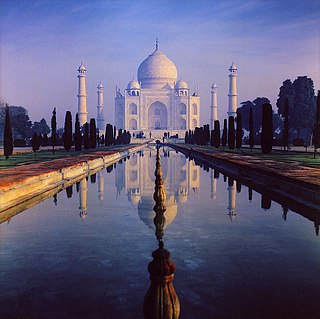Related Research Articles

Kanpur ( ), formerly anglicized as Cawnpore, is a large industrial city located in the central-western part of the state of Uttar Pradesh, India. Founded in year 1207, Kanpur became one of the most important commercial and military stations of British India. Kanpur is also the financial capital of Uttar Pradesh and part of upcoming Bundelkhand Industrial Development Authority i.e. BIDA Nestled on the banks of Ganges River, Kanpur has been the major financial and industrial centre of North India and also the ninth-largest urban economy in India. Today it is famous for its colonial architecture, gardens, sweets, dialect, IT parks and fine quality leather, plastic and textile products which are exported mainly to the West.

Kulpahar is a city in Mahoba district in the Indian state of Uttar Pradesh. It is a historical town in the Bundelkhand region. Before 11 Feb 1995 Kulpahar was a Tehsil of Hamirpur District. On 11 Feb 1995 Mahoba District was carved out of Hamirpur, and Kulpahar is now a part of the Mahoba District. Kulpahar is the largest Subdivision of Uttar Pradesh. Kulpahar is known for its closeness to Khajuraho and other historic places like Mahoba, Charkhari, Kalinjar Rath, Orchha, and Jhansi. This town holds relics of temples and man-made water bodies of the Chandela Dynasty
Jajmau also known as Jajesmow during British Era, is a suburb of Kanpur, India. It is situated on the banks of the Ganges River. Jajmau is an industrial suburb. It has the population of about 652,831 according to census 2011. It is believed to be the oldest inhabited place in the region. The main industry is the leather industry. It is home to some of the biggest leather tanneries in Northern India. The excavations conducted here by the Archaeological Survey of India suggest that it dates back to c. 1300 – 1200 BCE. Earthen pottery, tools and various historical artifacts discovered by the Archaeological Survey of India are presently kept in the Kanpur Sangrahalaya. The area comes under the jurisdiction of Kanpur metropolitan area.
Maudaha is a city and a Municipal Board in Hamirpur district, Uttar Pradesh, India.

Uttar Pradesh is the most populous state in India with a population of nearly 240 million people. The economy of Uttar Pradesh is the fifth largest among states in India. At current prices, the gross state domestic product (GSDP) of Uttar Pradesh is estimated to be ₹24.39 lakh crore (US$310 billion) in 2023–24. Merchandise exports from Uttar Pradesh reached US$21.03 billion in FY22.

Situated in the northern part of India, bordering with the capital of India New Delhi, Uttar Pradesh is one of the most popular and an established tourist destination for both Indians and non-Indians alike in India. The most populous state of India, Uttar Pradesh contains many historical monuments and places of religious significance. Geographically, Uttar Pradesh is very diverse, with Himalayan foothills in the extreme north and the Gangetic Plain in the centre. It is also home of India's most visited sites, Hinduism's holiest city, Varanasi. Kumbh city, Prayagraj. Kathak, one of the eight forms of Indian classical dances, originated from Uttar Pradesh. Uttar Pradesh is at the heart of India, hence it is also known as The Heartland of India. Cuisine of Uttar Pradesh like Awadhi cuisine, Mughlai cuisine and Bhojpuri cuisine are very famous not only in India but also many places abroad.

The architecture of Uttar Pradesh demonstrates a diverse and eclectic combination of Buddhist, Hindu, Indo-Islamic, and Indo-European architectural styles. Three of its architectural monuments—the Taj Mahal, the Agra Fort, as well as the township of Fatehpur Sikri founded by the Mughal emperor Akbar—are designated UNESCO World Heritage Sites. The architectural structures in Uttar Pradesh include ancient Buddhist stūpas and vihāras, ancient Buddhist and Hindu monasteries, townships, forts, palaces, temples, mosques, mausoleums, memorials, and other community structures. Uttar Pradesh's architectural structures also include various Hindu temples, Ghats, etc. largely found in ancient cities like Benares (Varanasi), Brindaban (Vrindavan), Mathura, and Prayagraj (Allahabad).

The following outline is provided as an overview of and topical guide to Uttar Pradesh:
References
- ↑ "List of Ancient Monuments and Archaeological Sites and Remains of Lucknow - Archaeological Survey of India". asi.nic.in. Retrieved 19 November 2016.